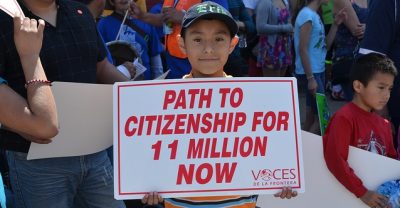Family-Based Immigration
Through family-based immigration, U.S. citizens and lawful permanent residents can sponsor relatives for immigration. We aim to be a leading force in transforming family-based immigration policy in order to maintain family unity, foster cohesive communities, and strengthen America’s economic growth. Read more about our approach below.

What Do You Think About Immigration Reform?
As the Senate continues to shepherd a comprehensive immigration reform bill through the legislative process (day two of mark-up in the Senate Judiciary Committee begins tomorrow), it becomes clear how many issues are at stake in reform and how interconnected they are. It’s also overwhelming at times. That’s why the American Immigration Council is attempting to divide the issues into smaller discussions on our wiki, ThinkImmigration.org. Read More

Immigration Activists Take to the Streets in May Day Rallies Around the Nation
Tens of thousands of people across the country—from New York to Vermont to California and Arizona—gathered at rallies and marches yesterday to demand immigration reform. Immigrants and advocates joined with labor groups, lawmakers, and other organizations for the May Day, also known as International Worker’s Day, demonstrations in dozens of cities. And their message was clear: Congress must pass immigration reform. Read More

Senate Hearing Reinforces Why Congress Needs To Pass Comprehensive Immigration Reform
For more than seven hours on Monday, the Senate Judiciary Committee listened to testimony from almost two dozen people about the immigration reform bill a bipartisan group of senators introduced last week. From visas for farm workers and other foreign workers to the mandatory E-Verify system included in the bill, senators debated and questioned the witnesses about all aspects of immigration reform. Read More

Guaranteeing Access to Health Care to Immigrant Women: A Necessary and Wise Investment
In the current public debate regarding comprehensive immigration reform, the focus on immigrant access to health benefits has been almost exclusively limited to cost (which is undeniably an important aspect) and has rarely addressed the social gains that result from investing in a healthy population. For the most part, the health of immigrant women has been left out of the discussion, which is, in many aspects, problematic. Read More

Immigration Watchdogs: Keep Calm and Press On
We’ve hit a point in the life cycle of the long awaited Senate immigration reform bill that a lot of parents will remember well. It’s those last few days before the baby is born, when anxiety and excitement are present in equal measure. Rather than speculating about the baby’s eye color or who the baby will resemble, however, speculation on the Senate immigration bill revolves around the bill’s substance. Will it carry through on the promise of a reasonable path to citizenship for the undocumented? How will it balance the interests of business and labor in a temporary worker program? Will there be additional STEM visas? Are there really going to be cuts to the family system in favor of some new mechanism for admitting employment and family based immigrants? There have been a host of media reports this past week fueling speculation on these questions and others, but the bottom line is that we simply won’t know until we see the text of the bill. Read More

The Promise and Challenges of Family-Based Immigration
Today the U.S. House Committee on the Judiciary is hosting a hearing on “The Separation of Nuclear Families under U.S. Immigration Law”. The issue to be addressed relates specifically to the obstacles that many legal permanent residents (LPR) currently living in the United States face when they try to bring their immediate relatives to the country. While there are neither country nor yearly caps for immediate relatives (currently defined as opposite-sex spouses and minor children) of U.S. citizens who want to immigrate to the United States, there are only 87,900 immigrant visas available each year for immediate relatives of LPRs. In addition, no country can receive more than 7 percent of the visas available for all immigration categories in a fiscal year. In 2012, for example, the maximum number of visas available per country was 47,250. And because the demand for visas in some countries is much larger than the number of visas available, some LPRs have to wait several years to be able to bring their spouses and unmarried children. Read More

The Advantages of Family-Based Immigration
Since the enactment of the Immigration and Nationality Act in 1965, legal immigration to the United States has been based primarily on the family ties or the work skills of prospective immigrants. Under the provisions of current immigration law, the family-based immigration category allows U.S. citizens and lawful permanent residents (LPRs), or “green card” holders, to bring certain family members to the United States. There are 480,000 family-based visas available every year. Family-based immigrants are admitted to the U.S. either as immediate relatives of U.S. citizens or through the family preference system. The contributions of family-based immigrants to the U.S. economy, local communities, and the national fabric are manifold. They account for a significant portion of domestic economic growth, contribute to the well-being of the current and future labor force, play a key role in business development and community improvement, and are among the most upwardly mobile segments of the labor force. This fact sheet provides an overview of the economic and social advantages associated with family-based immigration. In particular, it highlights the direct benefits resulting from the participation of family-based immigrants in the labor force, their contributions to the community, and the key—yet often underestimated—value of the unpaid care work provided by immigrant women. 1. Families are crucial to the social and economic incorporation of newcomers. Read More

Recognizing Immigrant Women’s Needs in Immigration Reform
While the recent debate over reauthorization of the Violence Against Women Act and the Trafficking Victims Protection Act may have reminded the nation that there are “women’s issues” in immigration law, it doesn’t necessarily follow that most people regard immigration reform as a woman’s issue. Despite the fact that immigrant women make up a growing share of workers, entrepreneurs, single heads of households, and new voters—while remaining primary caregivers in families—the laws we craft to reform our broken immigration system have often been insensitive to the obstacles and challenges immigrant women face in applying for immigration status. Read More

Skilled Immigrants Come Through All Immigration Channels
Note: Today’s blog features the oral testimony of Benjamin Johnson, Executive Director of the American Immigration Council before the House of Representatives, Committee of the Judiciary, Subcommittee on Immigration and Border Security today. Mr. Chairman and members of the committee, thank you for the opportunity to appear before you today and provide testimony on behalf of the American Immigration Council, a non-profit educational organization that for 25 years has been dedicated to increasing public understanding of immigration law and policy and the role of immigration in American society. Read More

Survey: Asian Americans Concerned with Legalization, Family Backlogs
In the current debate, immigration is often depicted as a Latino issue. This is partially because just over half of America’s foreign-born population is from Latin America and the Caribbean, and the current political climate around immigration is largely seen as being driven by Latino turnout for Democrats in the 2012 election. But this depiction glosses over the millions of immigrants – documented and undocumented – who hail from other parts of the globe. Read More
Make a contribution
Make a direct impact on the lives of immigrants.
